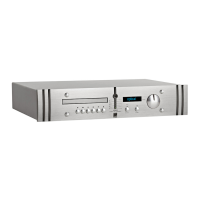2
CDA2 & SIACD
Introduction
Welcome. In selecting ATC you have chosen
an example of the finest audio engineering
available. ATC was founded on a principle
of engineering excellence, and that principle
still defines our products today. Given the
right opportunities, ATC products will
deliver exceptional audio performance, but
the opportunities will only arise from
careful and thoughtful installation and use.
Please read the following manual fully. It
will help you understand the product and
to realise its full potential. We are happy to
answer questions and offer advice on any
issues that arise through installation or use
of ATC products. Contact details can be
found at the back of this manual.
ATC was founded in London in 1974 by Australian
emigre Bill Woodman, who still heads the company
today. An enthusiastic pianist and engineer he was
naturally drawn to loudspeaker design and after a
period working at Goodmans, where many of the
names that went on to found British loudspeaker
companies began their careers, he struck out on
his own. The premise on which ATC began is a
simple one, and one that in many respects is still
true today: hi-fi loudspeakers tend to be detailed
and accurate but of limited dynamic range, while
professional monitor speakers tend to express the
opposite character. ATC products were designed
from the outset to offer the best of both. It’s an
easy concept to describe, but surprisingly difficult
to engineer.
The difficulty inherent in designing such
loudspeakers is one of scale. Hi-fi levels of accuracy
and detail call for lightweight moving parts and
delicate engineering. Professional monitor levels of
performance however demand far more robust
components engineered to survive the rigours of
high level use for extended periods. The only way
to combine the two is through precision
engineering of a class and scale more often
associated with aerospace or motorsport. But the
results are worth the effort and the cost. ATC
loudspeakers, with their unique in-house designed
drivers, combine the best of hi-fi and professional
to devastating effect.
ATC has become synonymous with active systems. Choosing to offer active
loudspeakers (where the passive crossover network is replaced by active filters and
multiple power amplifiers) is simply a result of the uncompromising attitude to
loudspeaker design. While passive systems still have their place, and ATC engineering
skills can still bring remarkable results from them, “active” is a fundamentally better
solution to the problems posed by accurate, high level music reproduction. The ATC
instinct is always for the better solution. Not cheaper, not quicker, but better.
It was the development of active loudspeakers that first brought ATC into electronics
design and engineering. Active speakers demand multiple power amplifiers so ATC
from the mid 1980s became not just a loudspeaker manufacturing company but an
electronics manufacturer too. The further step from electronics for active speakers
to a range of stand-alone amplifier products was natural and now means that ATC
engineering is available from the recording desk or CD player output to the ears.
From modest beginnings ATC has grown to become one of the very few
manufacturers successful across both domestic and professional audio. By selecting
ATC you join a group of music lovers, professional audio engineers, studios and
musicians across the world that understand and value the engineering that goes into
an ATC product - and the sound that comes out.

